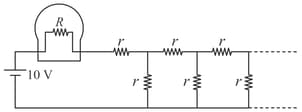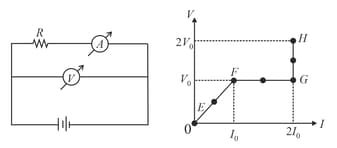Embibe Experts Solutions for Chapter: Current Electricity, Exercise 2: Exercise 2
Embibe Experts Physics Solutions for Exercise - Embibe Experts Solutions for Chapter: Current Electricity, Exercise 2: Exercise 2
Attempt the practice questions on Chapter 14: Current Electricity, Exercise 2: Exercise 2 with hints and solutions to strengthen your understanding. Practice Book for KVPY Aptitude Test - Stream SA Physics solutions are prepared by Experienced Embibe Experts.
Questions from Embibe Experts Solutions for Chapter: Current Electricity, Exercise 2: Exercise 2 with Hints & Solutions
Consider the circuit shown below where all resistors are of

If a current of magnitude flows through the resistor marked , what is the potential difference measured between point and .
A light bulb of resistance is attached in series with an infinite resistor network with identical resistances r as shown below. A battery derives current in the circuit. What should be the value of such that the bulb dissipated about of power.

The primary and the secondary coils of a transformer contains and respectively. The primary coil is connected to a battery that supplies a constant voltage of . The voltage across the secondary coil is
Water falls down a shaft to reach a turbine which generates electricity. How much water must fall per second in order to generate watts of power ? (Assume efficiency of conversion and )
In the circuit, wire is of negligible resistance. Then

In the circuit shown below (on the left) the resistance and the emf source are both variable. The graph of seven readings of the voltmeter and the ammeter ( and , respectively) for different settings of resistance and the emf, taken at equal intervals of time , are shown (on the right) by the dots connected by the curve . Consider the internal resistance of the battery to be negligible and the voltmeter and ammeter to be ideal devices. Take .

Then the plot of the resistance as a function of time corresponding to the curve is given by
In a particle accelerator, a current of is carried by a proton beam in which each proton has speed of . The cross-sectional area of the beam is . The charge density in this beam in is close to
A steady current is set up in a wire whose cross-sectional area decreases in the direction of the flow of the current. Then, as we examine the narrowing region
